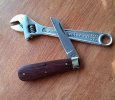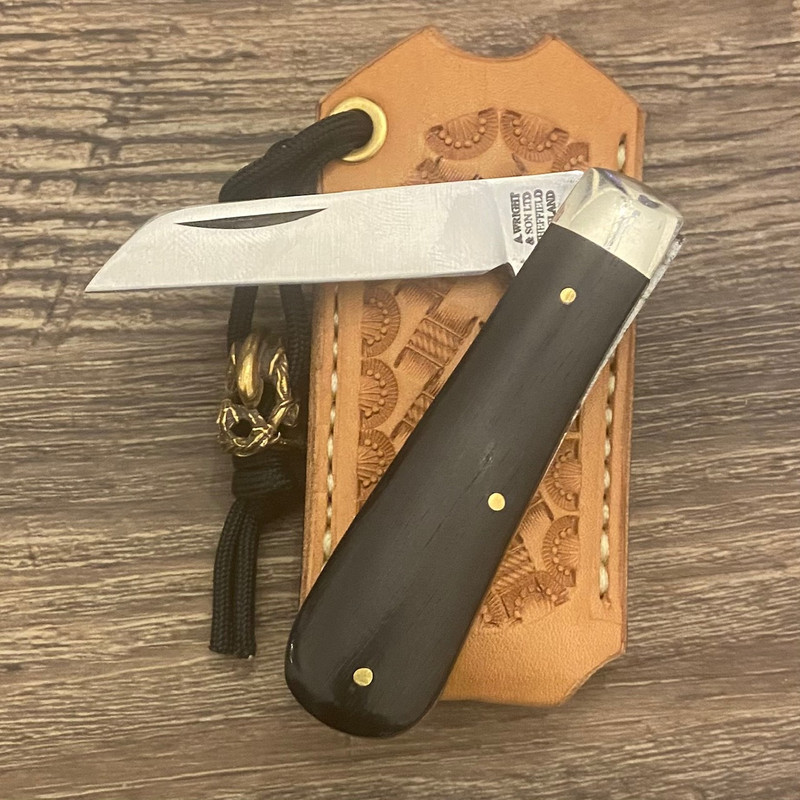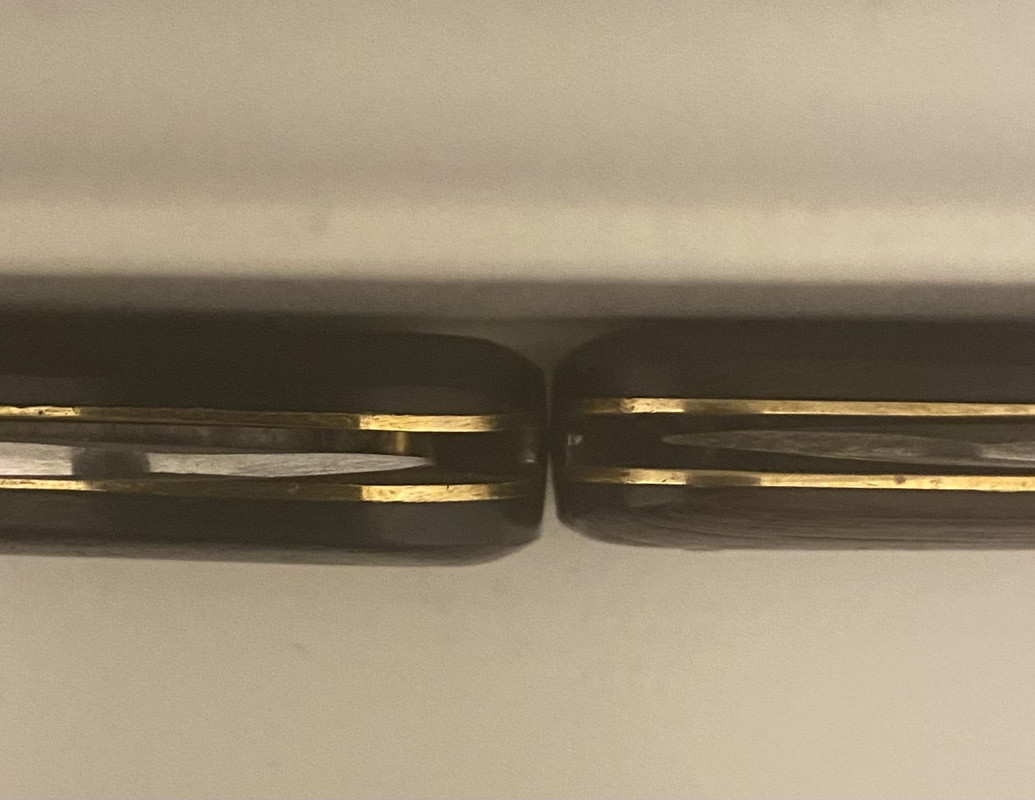I have always been heavy on footwear, and while I remember having to replace laces often when I was young, these days, I often find my shoes are worn out before the laces (I always remove the old ones before throwing them out)!

I save the old ones as spares


Nice work Leon, and a good-looking pair of daisy roots

Great-looking Lambsfoot too


In looking at very old and heavily used lambsfoot knives (some on this thread and some just browsing around the web) it seems like very few retain the straight edge blade after many sharpenings. I see most either end up with a little belly at the tip (turning them into some kind of drop point, I guess) or end up with a lot of recurve. (Or a lot of recurve AND a turned-up tip.) I've seen a few people say that the tip on newer knives ends up rounded off after one or two sharpenings because they tend to be pretty soft at the tip (mine tends to roll the edge a little at the tip so I could see that), but most of the knives I'm talking about seem to be pretty old (where the blade has been sharpened so many times that it's got a skinny profile now).
While I've seen plenty of other patterns that were sharpened so much over the years that it changed the blade profile, it feels like I'm seeing more lambsfoot knives like this than I've noticed in other patterns. Seems like this might indicate how long people used these - as long as there's some usable blade, just sharpen it up and keep going. No pics for this comment, since my lambsfoot is still pretty new (and I didn't want to steal other's pics), but still an observation I wanted to share. It's not just that the pattern itself has been around for a while, but individual knives in this pattern can have a particularly long working life.
We certainly see some very old Lambsfoot knives here in this thread, but their previous owners may not have had so much knowledge about sharpening, or had the equipment, that the average member does here. Even when I was a boy, I commonly saw people crudely sharpening knives on kerbstones or on the cellar steps. While I've seen many old Lambsfoot knives deformed out of all recognition by poor sharpening, I've seen others that have been sharpened almost to the point where there was almost nothing left, but still retaining a straight edge. Without that straight edge, and the sharp point, you're really losing the best properties of the Lambsfoot blade. I don't think this is a problem distinct to the Lambsfoot pattern though, I see just as many other old knives, which are mangled at least as badly. Unfortunately, once a knife loses its point, develops a recurve, or is damaged somehow, it tends to be relegated further down the knife food-chain, and rather than being restored, simply gets more abuse

Here's a few I have pics of. This old Alfred Blackwell had clearly had a very hard life, with half the bone missing off the pile side, and the blade pushed into the liner, as if it had been run over. Yet, it was still razor sharp, and I used to carry it often.
This old J. Howarth was knifemaker Paul Mason's boyhood knife. At some point, Paul had accidentally damaged the point.
 r8shell
r8shell
has this old Thomas Turner, and I think made a useful punch out of it


I suspect this old Abram Brooksbank Lambsfoot was damaged at some point, and that someone decided to make a useful knife out of it. It's been modified so much that I don't usually show it here, but the second photo shows how it would have looked originally.
This Joseph Rodgers has been heavily used and abused, but despite its ugliness, it still retains the characteristics of a Lambsfoot.
This Thomas Turner has pretty much been 'used to death'!

It still has a straight edge at least

This old Herbert Robinson is one of 3 Lambsfoot knives
 Fixall
Fixall
kindly sent me recently. It's clearly had a hard life


The Milner has simply lost its tip, but is spoiled because of that unfortunately ;( Maybe I'll put it right at some point

Afternoon Guardian's. Hope everyone has had a good day and is settling in for a enjoyable evening.
View attachment 1698637
Great photo there


A few years after college, while Julie was doing her post-grad-school internship, I got dragged along to a dinner party at her internship director’s house. I wasn’t particularly excited about going, and may have had a few drinks before we left, and then a few more when we got there. At one point during the evening, the internship director comes up and says to me (in German), “So, Julie tells me that you speak German?” Turns out she was fluent, and I’d had just enough to drink to think I could actually hold a conversation in German. It was rough.


LOL!

That sounds like the sort of clanger I'd make Barrett!


A good discussion to have about the Lambsfoot blade, and some good observations. I will keep this simple in 2 parts. Firstly, recurves or bellies on a Lambsfoot blade are usually caused by sharpening technique, and what i mean by that, is the the person sharpening the blade has a flawed sharpening technique and is nor keeping the blade flat on the stone, sometimes this is caused by them being used to sharpening other blade shapes where they lift the blade as the get to the tip, a lot of muscle memory is used in sharpening a knife. If this is carried over to a Lambsfoot or similar blade, this can cause a belly or recurve on the Lambsfoot blade. I don't want to go over old ground i have already posted my love of the Lambsfoot and the other one that shan't be mentioned here



when i first encountered them over 1/2 a century ago in the stock and sale yards of Western Victoria, the farmers and stockman that used them loved their versatility and ease of sharpening. But they knew how to sharpen them. In regards to the older Lambsfoot knives you mention, things have changed since those days, they only had silicon carbide or aluminium oxide stones, or if they could source them Arkansas stones at their disposal, now we have a plethora of sharpening equipment. We now have any amount of different stones and equipment, but also ceramic rods, and strops of all kinds, leather, woods etc. etc.. Now here is the thing, every time you sharpen a knife blade, and i mean sharpen, not hone or touch up on a ceramic rod or strop you shorten it's lifespan because you are removing metal, think of Bluestone or Granite steps at the front of a centuries old building, they are dished out by millions of people walking up and down on them, it is the same with a blade, the more metal you remove with sharpening you can get uneven wear. But if you get a blade really sharp for your needs, then just hone it to keep it sharp, it will last a life time for most users. Here is an example. i have had this Lambsfoot of Charlie's for nearly 2 and a 1/2 years, it took 2 years before i had to take it to a stone, because i just stropped it when needed. But a very interesting conversation to have, and i'm sure there will be plenty who disagree with me and i would not have any other way in the Guardians. Have a good weekend.

All good points Leon

Many of us here having been carrying and using Lambsfoot knives for a good few years now, but we don't really see rounded points or recurved blades, because I think we probably take better care of them than the average punter

Looking forward to hearing more opinions on this interesting discussion point

Good morning Guardians, it's a bit brighter here today, but my mate, who I usually meet up with on Fridays, has his daughter's nativity play today, so I'm left to my own devices

I think I'm going to have to head into town at some point unfortunately, but maybe I can wangle a piece of cake somewhere

I hope everyone has had a good week, and that you have something to look forward to at the weekend. Unfortunately, I think we have more rain on the way here

Carrying my Hartshead Barlow again today

Have a good Friday Guardians

























